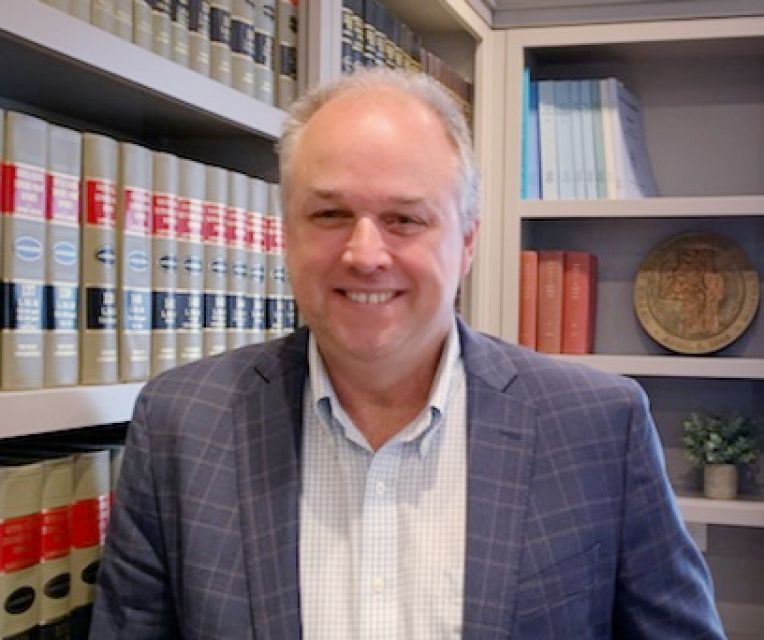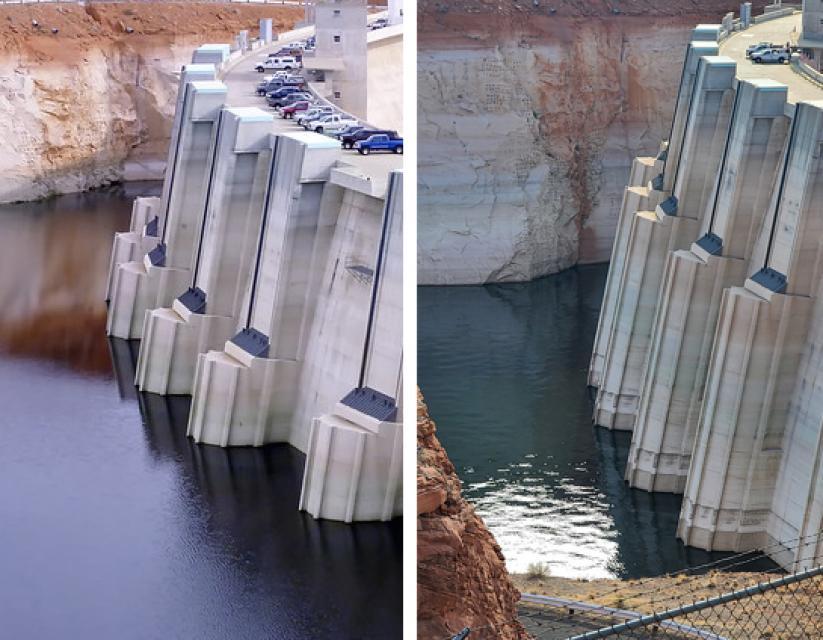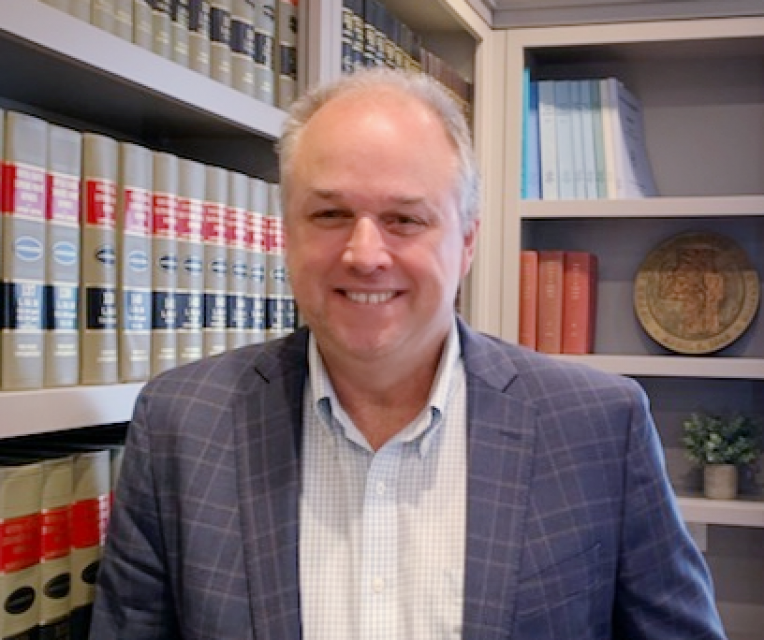A Colorado River Veteran Moves Upstream and Plunges into The Drought-Stressed River’s Mounting Woes
WESTERN WATER Q&A: Chuck Cullom, a longtime Arizona water manager, brings a dual-basin perspective as top staffer at the Upper Colorado River Commission
 With 25 years of experience working
on the Colorado River, Chuck Cullom is used to responding to
myriad challenges that arise on the vital lifeline that seven
states, more than two dozen tribes and the country of Mexico
depend on for water. But this summer problems on the
drought-stressed river are piling up at a dizzying pace:
Reservoirs plummeting to record low levels, whether Hoover Dam
and Glen Canyon Dam can continue to release water and produce
hydropower, unprecedented water cuts and predatory smallmouth
bass threatening native fish species in the Grand Canyon.
With 25 years of experience working
on the Colorado River, Chuck Cullom is used to responding to
myriad challenges that arise on the vital lifeline that seven
states, more than two dozen tribes and the country of Mexico
depend on for water. But this summer problems on the
drought-stressed river are piling up at a dizzying pace:
Reservoirs plummeting to record low levels, whether Hoover Dam
and Glen Canyon Dam can continue to release water and produce
hydropower, unprecedented water cuts and predatory smallmouth
bass threatening native fish species in the Grand Canyon.
“Holy buckets, Batman!,” said Cullom, executive director of the Upper Colorado River Commission. “I mean, it’s just on and on and on.”
Cullom is keeping tabs on the river’s rapidly growing list of issues while guiding the Upper Basin states of Colorado, Wyoming, Utah and New Mexico in talks with other water users on how to save a river system that is crashing under the weight of drought and climate change. Demand continues to greatly outstrip supply and now state officials, water users and tribes are hurrying to craft a new drought plan and avoid intervention from the federal government.
“While we may want to isolate issues or challenges in one basin or another, we are tied together.”
~Chuck Cullom, executive director of the Upper Colorado River Commission
The Upper Basin has proposed a plan built around paying users to reduce water consumption. Though it doesn’t include mandatory cuts for water users, Cullom and the commission have made it a focal point of their negotiations with the Lower Basin.
Cullom spent the last two decades viewing issues on the river through a Lower Basin lens, managing drought strategies and mitigation plans for the Central Arizona Project. Now, in his first year at the commission, Cullom has the chance to use his dual-basin perspective to help the seven states and 30 federally recognized tribes hash out ways to divide the river, which continues to shrink swiftly.
In an interview with Western Water, Cullom explains the importance of communicating effectively on the river, why the Upper Basin’s five-point plan doesn’t require mandatory water cuts or offer potential savings amounts and the push to make the Lower Basin responsible for evaporation losses at Lake Mead.
WESTERN WATER: How has your previous experience in the Lower Basin prepared you for your current position as you switch your focus to the significant challenges facing the Upper Basin?
CHUCK CULLOM: One of the things that I learned over the course of my experience in the Lower Basin was that while we may want to isolate issues or challenges in one basin or another, we are tied together. So that was very important as I transitioned from Lower Basin to Upper Basin, recognizing that while we may want to isolate the issues between Upper and Lower, they cascade in both directions.
 I understood early on that the Lower
Basin perspective on how the system operates is different and
unique from the Upper Basin. Water uses and management in the
Upper Basin reflect and are driven by annual hydrologic
circumstances, meaning that the hydrology and inflows that occur
influence water management decisions year over year. Whereas the
Lower Basin relies principally on storage in Lake Powell and Lake
Mead. When your perspective is so distinct and different, you
have to be very careful about what you say and how you say it.
I understood early on that the Lower
Basin perspective on how the system operates is different and
unique from the Upper Basin. Water uses and management in the
Upper Basin reflect and are driven by annual hydrologic
circumstances, meaning that the hydrology and inflows that occur
influence water management decisions year over year. Whereas the
Lower Basin relies principally on storage in Lake Powell and Lake
Mead. When your perspective is so distinct and different, you
have to be very careful about what you say and how you say it.
WW: Can you expound on the difficulty of communicating on such a large river system?
CULLOM: I had an experience in the early days of the system conservation pilot program in Arizona. The words we were using to describe how we were managing our uses, while useful and appropriate for what we were doing internally to Arizona, was offensive and inappropriate for the Upper Basin because it implied things that weren’t true. And the Upper Basin folks thoughtfully reached out and communicated directly … and then we figured out how we were going to work together. When you experience the world differently because you’re upstream or downstream of Glen Canyon Dam, communication becomes very important.
And it’s the same with tribal engagement. … The Upper Division [Basin] commissioners met with the tribal leaders for the six Upper Basin tribes and had a very thoughtful, frank and open discussion about the importance of working collaboratively on interstate Colorado River issues and what is helpful and unhelpful in that context. And it was a very useful conversation.
WW: In moving from the Lower Basin to the Upper Basin, has anything involving the Colorado River surprised you? How has your perspective changed?
CULLOM: One thing that surprised me is that the technical capacity in the Upper Basin is on par and in some instances higher than what I anticipated; it exceeds some of the capacity in the Lower Basin. Folks up here are super smart, super talented and lots of modeling expertise is engaged every day.
WW: In June, Reclamation Commissioner Camille Calimlim Touton called on the seven Basin states to devise a plan to reduce use of the river to protect Lake Powell and Lake Mead. She also indicated that all users will have to take cuts. Are Upper Basin states preparing to take cuts? And how might these cuts play out?
CULLOM: I don’t think the question is about are we prepared, it’s how effective our actions will be. The magnitude of contributions in the Upper Basin is limited by the tools we have, the hydrologic and geographic circumstances and what happens in the Lower Basin. So, for the five-point plan to be effective, it needs significant actions in the Lower Basin. But we are moving forward with our plan with the expectation that everyone will contribute in a meaningful way.
WW: What is the goal of the Upper Basin’s five-point plan and what has been the response from Reclamation or the Lower Basin?
CULLOM: The plan includes tools that lead to additional conservation in the Upper Basin on top of what is inflicted by hydrology in dry years, plus contributions that have been made through the 2019 Drought Response Operating Agreement.
The one criticism that we’ve received is “why didn’t you quantify your system conservation program?” We didn’t know if we would have funding and support from Reclamation and we didn’t know what the appetite of water users would be to take on even more reductions. So we didn’t think it would be appropriate to speculate on what we might achieve as an aspiration; we’re focused on delivering results rather than projecting what might be.
Two of the Lower Basin states (California & Arizona) have questions, Nevada is supportive and Reclamation has expressed support and provided resources to help us implement the plan.
WW: The five-point plan talked about reviving work on a demand management plan that was supposed to be part of the 2019 Drought Contingency Plan (DCP). Earlier this year, the Colorado Water Conservation Board halted work on such a plan because, it said, Colorado was much further ahead on investigating the concept than the other Upper Basin states (New Mexico, Utah and Wyoming). Is demand management a viable concept for the Upper Basin and what’s been done?
CULLOM: Colorado’s so-called pause on demand management is not that. The interstate work through the commission is continuing and will be completed in the fall and it will provide a report by the end of the year. I think Colorado was indicating that they had enough information and didn’t need any additional consultants or studies as they complete their own homework.
“We need to bring the system depletions into balance with the available supply every year and rebuild the resiliency in the system by replacing the depleted storage.”
~Chuck Cullom, executive director of the Upper Colorado River Commission
WW: How can Congress and the federal government help in facilitating a plan to keep the river system from crashing?
CULLOM: Congress has been very helpful. They passed the DCP and they passed the Inflation Reduction Act funding. We’re appreciative and trying to put that funding to very good use.
For the long-term perspective, Commissioner Touton identified tools that she is going to explore and develop and potentially implement in the Lower Basin, including appropriate accounting for evaporation and [transmission] losses. There’s about 1.2 million acre-feet of water that is unaccounted for in the Lower Basin that contributes to the imbalance between supply and demand. And the impact of that imbalance is higher releases from Glen Canyon Dam at a time when Glen Canyon Dam is in jeopardy. We support her efforts to try and bring the Lower Basin system into balance just like the way the Upper Basin accounts for evaporation and transmission losses. We think the secretary has significant authority to do that.
WW: With aridification shrinking the river supply and the disparity in use between the two basins, do you think re-apportioning the river is a serious possibility in the future?
CULLOM: I don’t think it’s warranted or helpful.
WW: In the short term or it’s just a concept that’s just absolutely not in play?
CULLOM: Well, folks can want to talk about it but trying to reconfigure [river apportionments] right now seems like you would create more uncertainty than you’re trying to resolve. In addition, there are the folks who would be most at risk from that conversation in underserved communities and tribes. There are significant tribal water rights that are confirmed but undeveloped.
I think there is significant room for flexibility to adapt to the ongoing drought and for aridification, climate change or whatever you want to call a hotter, drier future. And we need to work within the within the regulatory framework we have because otherwise it becomes a discussion about brute political force rather than what the system needs collectively.
WW: Looking ahead to the renegotiation of the 2007 Interim Guidelines, what are some of the main priorities for the Upper Basin?
CULLOM: We absolutely need a new set of rules. Extending rules that are under stress is not, I don’t believe, a viable option. A significant goal for the next set of rules is to bring the Colorado River uses into balance. By uses I mean including evaporation and losses. We need to bring the system depletions into balance with the available supply every year and rebuild the resiliency in the system by replacing the depleted storage. I think that’s the framework that the Upper Basin is seeking to explore.
Chuck Cullom
- Education: Bachelor’s degree in geology from the University of Arkansas, master’s degree in geology from Northern Arizona University
- Current job: Upper Colorado River Commission Executive Director
- Previous jobs: Central Arizona Project’s (CAP) Manager of Colorado River Programs, Bookman-Edmonston Engineering and for the Arizona Department of Water Resources
- Fun or interesting fact: Cullom has been known to “Call the Hogs” — a University of Arkansas traditional chant— at sporting events with other fans and alumni following Razorback victories: Wooo. Pig. Sooie!
Reach Writer Nick Cahill at ncahill@watereducation.org, and Editor Doug Beeman at dbeeman@watereducation.org.
Know someone else who wants to stay connected with water in the West? Encourage them to sign up for Western Water, and follow us on Facebook , Twitter, LinkedIn and Instagram.










